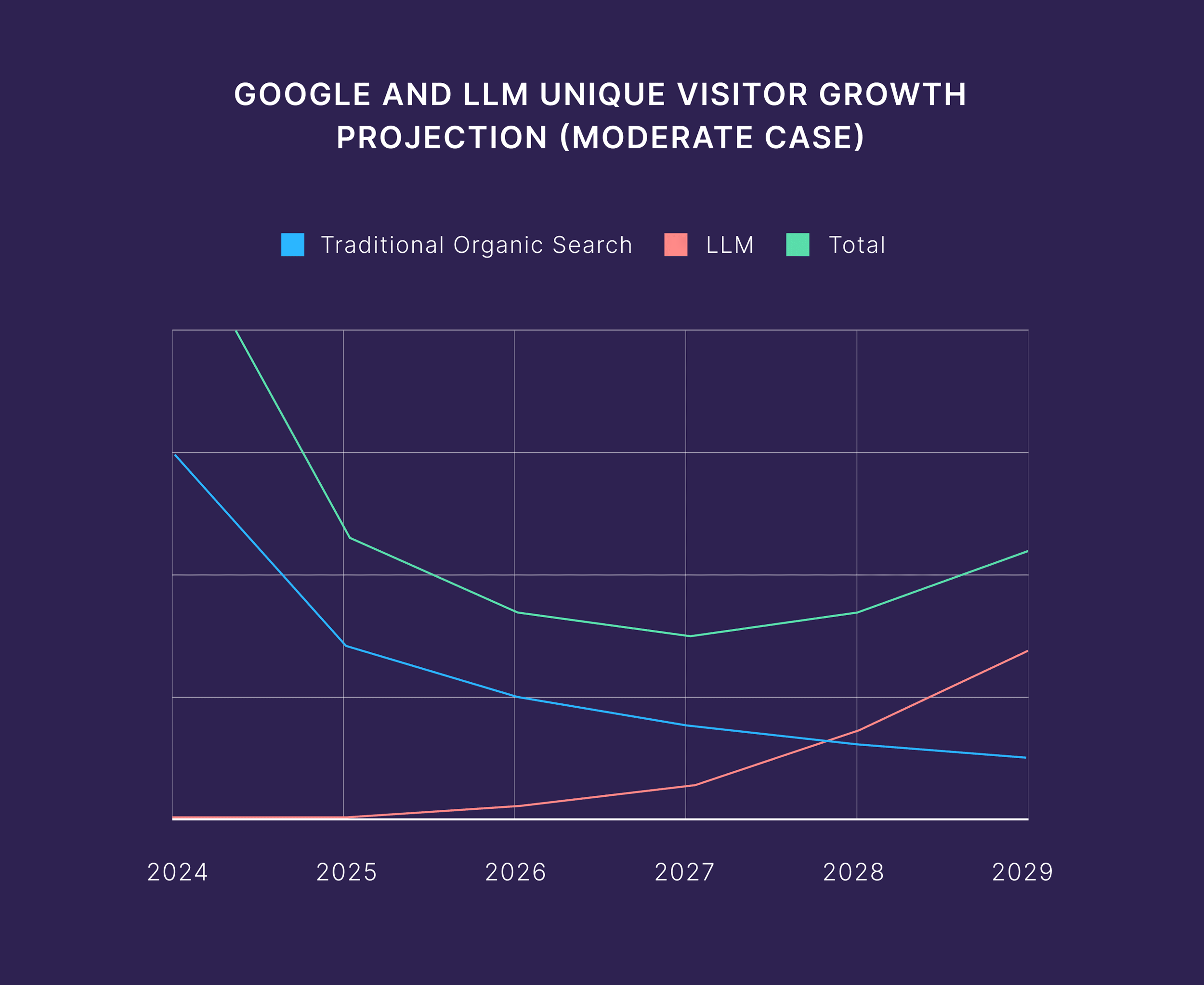9 min to read
The Seismic Shift in Digital Visibility
I’ve been in the digital trenches for years, and I can tell you, the ground beneath our feet is shifting faster than ever. What worked yesterday for digital visibility won't guarantee success tomorrow. We're on the cusp of a profound transformation, driven by the explosive growth of artificial intelligence in search. This isn't just another SEO update; it's a fundamental re-architecture of how users find and consume information online. At Codedesign, we're seeing it firsthand: platforms like Google AI Overviews (AIOs), ChatGPT, and Perplexity are becoming the first port of call for an increasing number of queries, synthesizing information directly to provide concise answers. This isn't just a trend; it's a paradigm shift. The data is clear: AI-driven traffic converts 4.4 times better than traditional search, and Ahrefs even reports a 23x higher conversion rate.

This isn't about vanity metrics; it's about measurable commercial impact. The game has changed from ranking to citation, from clicks to becoming an authoritative source within AI's answer-generating frameworks. This article will give you my blueprint for how to optimize for AI search results in 2025 (what we know so far), focusing on the actionable strategies of Generative Engine Optimization (GEO) that we're implementing to help businesses thrive.

Understanding the AI Search Revolution
The digital landscape is undergoing a rapid evolution, driven by the increasing prominence of artificial intelligence in search. This transformation is reshaping how users seek information and how brands achieve visibility.
The Rise of AI Overviews and Conversational AI Platforms
Conversational AI tools like ChatGPT, Google AI Overviews (AIOs), and Perplexity AI are attracting substantial audiences. ChatGPT has rapidly ascended to become the #5 most-visited site globally, handling an estimated 4-5% of all "search" queries by early 2025. Google AI Overviews are expanding their presence at a remarkable pace, appearing for 10.4% of U.S. desktop keywords and showing a significant 119% increase on mobile in March 2025. This widespread adoption signifies that AI-generated summaries are no longer experimental features but are integral to the contemporary search experience.
The Undeniable Value of AI-Driven Traffic
While some predicted a substantial decline in organic traffic due to AI-generated summaries, the quality of traffic driven by AI is demonstrably superior. As I mentioned, AI-driven traffic converts 4.4 times more effectively than traditional search traffic, and Ahrefs reports an astounding 23 times higher conversion rate. This superior conversion rate is because AI platforms effectively pre-qualify users, delivering them to your site with more context and higher intent. The initial discovery phase is shifting towards AI-driven pre-qualification and citation, leading to a more efficient, higher-intent conversion path.
The Paradigm Shift: From Traditional Ranking to AI Citations and Authority
The objective in this evolving search landscape is no longer solely to achieve high rankings in the "10 blue links" of traditional search results. Instead, the focus has shifted to being cited as a trusted source within AI's generated answers. This means your brand must strive to become "the voice AI chooses to represent the answer". Generative Engine Optimization (GEO), also referred to as AI Search Optimization (AEO), represents a fundamental departure from traditional SEO. While traditional SEO emphasizes keywords and link-building, GEO prioritizes user intent, context, and content quality. AI models consider the semantic meaning of phrases rather than merely individual keywords. Success in AEO is measured by whether your content is selected and cited in the AI-generated answer. The integration of ads within Google AI Overviews further underscores a convergence of organic and paid visibility, necessitating a holistic and integrated marketing strategy. The following table provides a clear comparison between traditional SEO and Generative Engine Optimization (GEO) or AI Search Optimization (AEO), highlighting the key differences in focus, goals, and strategies.
| Dimension | Traditional SEO | Generative Engine Optimization (GEO)/AI Search Optimization (AEO) |
| Focus | Keywords, Link-building | User Intent, Context, Semantic Meaning, Content Quality |
| Primary Goal | Ranking on Search Engine Results Pages (SERPs) | Citation in AI Answers |
| Key Ranking Factors | Keywords, Backlinks, Domain Authority | E-E-A-T, Structured Data, Semantic Clarity, Topical Authority |
| Content Strategy | Keyword Stuffing (past), Volume | Direct Answers, Conversational Language, Chunk-Level Optimization |
| Metrics of Success | Organic Traffic, Rankings, Pageviews | AI Share of Voice, Citations, Conversion Rate of AI Traffic |

Laying the Groundwork: Look into the Engine for AI Visibility
Achieving prominence in AI search results hinges on a robust technical foundation. Without proper technical readiness, even the most compelling content may remain undiscoverable by AI systems.
Opening the Gates: Ensuring AI Crawlers Can Access Your Content
The foundational step is to ensure that AI bots can effectively access and process your content. This requires reviewing robots.txt files and server logs to explicitly permit known AI crawlers like GPTBot, Googlebot (including Google-Extended), bingbot, ClaudeBot, CCBot, and PerplexityBot. You must also whitelist these bots within firewall or CDN rules to prevent blocking or rate-limiting. If AI systems cannot crawl your site, they cannot identify or cite your content.
The Critical Role of Server-Side Rendering (SSR) and Avoiding JavaScript Pitfalls
Many AI systems struggle with rendering JavaScript-heavy content. To guarantee full accessibility and indexability by all AI models, implementing Server-Side Rendering (SSR) or pre-rendering for all critical content is crucial. A quick check: view your page source (Ctrl+U) to confirm all vital information is present as plain HTML. If key content isn't visible in the initial HTML, AI systems will likely miss it. This highlights that AI optimization is fundamentally a technical SEO challenge that must be addressed first.
Strategic Use of robots.txt, noindex, and nosnippet Directives
Avoid using noindex on valuable content intended for surfacing in AI answers. Similarly, avoid the nosnippet rule, which prevents AI Overviews and AI Mode from utilizing your content as a direct input for their summaries. These common oversights can severely limit AI visibility.
Canonicalization and Robust Internal Linking for AI Comprehension
Implementing canonical tags is essential for specifying the correct URL versions of pages, aiding AI systems in identifying and utilizing the appropriate page for content retrieval and synthesis. Optimizing your internal linking structure with crawlable links and descriptive anchor texts is also vital. This helps AI crawlers comprehend page context and semantic connections, crucial for establishing topical authority.
Site Speed and Mobile Performance: Non-Negotiables for AI Indexing
Fast, mobile-friendly websites ensure efficient crawling by all bots, including AI, and contribute to a positive user experience. Slow page loading speeds are a direct barrier to AI indexing. This isn't just a marketing task; it demands a unified, cross-functional approach between marketing/SEO and development/IT teams.

Engineering Content for AI Citation and Authority
Beyond technical readiness, the effectiveness of AI search optimization hinges on how content is engineered. The goal is to create content that is not only discoverable but also highly citable and authoritative in the eyes of AI.
Clarity and Structure are King
AI models prioritize content that is clear, concise, and well-structured, allowing for efficient extraction and synthesis of information.
Crafting Direct, Concise Answers: The "Answer-First" Approach
AI models favor content that provides direct, succinct answers to user queries. For optimal display in Google AI Overviews, answers to FAQs should follow a specific structure: an opening statement (10-15 words), supporting detail (20-30 words), and an authority indicator (5-10 words), totaling an optimal length of 35-55 words. Lead with the answer, then elaborate, avoiding unnecessary "fluff". This modular clarity is paramount for AI's "chunk-level retrieval" capabilities.
Leveraging Conversational Language and Question-Answer Formats (FAQs)
Content should utilize conversational language that mirrors how people speak. Implementing clear question-and-answer formats, especially through dedicated FAQ sections, directly aligns with how AI platforms structure citations and answers. Focus on informational, question-based queries like "What is..." or "How does...".
Implementing Clear, Logical Heading Structures (H2s and H3s) and Scannable Formats
Every page needs one clear tag, followed by logical and tags. These headings act as "signposts" for AI, outlining content hierarchy. Breaking information into bullet points or numbered lists is highly beneficial, as AI systems appreciate simple, digestible formats.

The Power of Structured Data (Schema Markup)
Schema markup, or structured data, is essential. It explicitly communicates to AI models what content is about, significantly enhancing contextual understanding and increasing the likelihood of citation. Implement JSON-LD for schemas like Article, HowTo, FAQPage, Organization, and Person. FAQ schema, in particular, remains actively supported and is a critical differentiator.
Building Unquestionable Trust and Expertise (E-E-A-T)
AI systems prioritize content from authoritative and trustworthy sources, aligning with the E-E-A-T principles.
Showcasing Authorship and Credentials
AI doesn't readily trust "faceless content". Include author bylines with concise bios detailing credentials and links to authoritative profiles (e.g., LinkedIn). Consistent author bios reinforce semantic identity.
Citing Verifiable Sources and Original Research
To earn attribution, content must be factually accurate, up-to-date, and well-supported. Include specific, verifiable claims and link to original reports, studies, and reputable databases. Original, primary-source content with clear E-E-A-T signals is highly valued.
Developing Topical Authority Through Content Clusters and Comprehensive Guides
AI favors content from sites demonstrating deep topical authority. Build this by creating "topic clusters"—multiple interlinked pages comprehensively covering the same theme. Start with a pillar page, then create focused content on narrower, related topics, internally linking them with descriptive anchor text.
The Importance of Consistent Brand Mentions and High-Quality Backlinks
AI Overviews draw from trusted sources, making consistent brand mentions and high-quality backlinks crucial. Building brand authority through PR, guest posts, and industry profiles enhances AI visibility. The table below outlines optimal content structure elements and their corresponding AI optimization strategies, along with why these strategies are crucial for AI comprehension and citation.
| Element | AI Optimization Strategy | Why it matters for AI |
| Headings (H1, H2, H3) | Descriptive, logical hierarchy | Signposts content hierarchy, aids chunk-level retrieval |
| Paragraphs/Sections | Concise, one idea per chunk | Improves answer synthesis, enhances contextual understanding |
| Lists/Bullet Points | Digestible, modular clarity | Facilitates extraction of key points, boosts citation-worthiness |
| Tables | Structured data, easily parsable | Enables AI to extract and present comparative data directly |
| FAQs | Direct answers, Q&A format, optimal length (35-55 words) | Directly maps to AI's answer generation, highly citable |
| Schema Markup | Implement JSON-LD for Article, HowTo, FAQPage, Organization, Person | Enhances contextual understanding, positions content for direct answers |
| Media (Images/Videos) | Descriptive file names/alt text, schema markup (ImageObject, VideoObject) | Supports multimodal search, helps AI understand visual content |

Measuring What Matters: Tracking AI Visibility and Commercial Impact
The shift to AI-driven search necessitates a fundamental re-evaluation of how digital marketing success is measured. Traditional metrics, while still holding some relevance, no longer provide a complete picture of a brand's performance in the AI era.
Beyond Clicks and Rankings: New Metrics for the AI Era
Traditional SEO metrics like organic traffic volume and keyword rankings are insufficient on their own. Marketing teams must adapt their analytics to track new indicators:
-
AI Share of Voice (SOV): Quantifies the proportion of AI mentions that include your brand versus competitors.
-
Citations: Instances where AI systems directly name your brand, link to your content, or paraphrase your insights.
-
Sentiment & Accuracy: Assessing whether AI's portrayal of your brand is positive, accurate, or misleading.
-
Prompt Performance: Identifying which specific user queries trigger AI responses that reference your brand. This shift in traffic quality and the emergence of new visibility metrics demand a fundamental adaptation of Key Performance Indicators (KPIs).
Understanding the True Value of AI-Driven Traffic: High Conversion, High Intent
As I've emphasized, AI-driven traffic exhibits significantly higher conversion rates—4.4 times higher by Semrush, and 23 times higher by Ahrefs. This efficiency is a direct result of AI pre-qualifying users, delivering them to your site with greater context and higher intent. A lower volume of AI traffic can yield superior business outcomes. Focus on the quality and conversion efficiency of AI-driven visits. Tools like Google Analytics 4 (GA4) attribution and proper UTM parameters (which ChatGPT notably added in June 2025) are indispensable.
Tools and Strategies for Monitoring Your Brand's Presence in AI Search Results
Specialized tools are rapidly emerging to track these new AI-centric metrics. When selecting a tool, consider platform coverage (ChatGPT, Perplexity, Google AIO, Gemini), data quality, metrics tracked, competitor analysis, alerts, reporting, usability, and pricing. Leading tools available in 2025 include:
-
SE Ranking AI Visibility Tracker: Monitors brand mentions and links across Google AI Mode, Perplexity, and Gemini.
-
Profound AI: Enterprise-level platform tracking brand share of voice, citation sources, and AI crawler analytics across ChatGPT, Perplexity, and Google AIO.
-
ZipTie: Provides weekly visibility scores, breakdown charts, and AI summary trends across ChatGPT, Perplexity, and Google AI Overviews.
-
Peec.ai & Otterly.ai: Entry-level options for SMBs and smaller teams.
-
Athena (and peers like Scrunch AI, Rankscale): Emerging tools analyzing how AI models find and represent brands, offering optimization suggestions. The emphasis on tracking "share of voice" against competitors highlights that AI visibility is a new and critical battleground for competitive advantage. The following table summarizes key AI visibility tracking tools and the metrics they capture, along with their ideal user profiles.
| Tool Name | AI Engines Covered | Metrics Captured | Ideal Users |
| SE Ranking AI Visibility Tracker | Google AI Mode, Gemini, Perplexity | Mentions, links, competitor view | Mid–large SEO agencies & Marketing professionals |
| Profound AI | ChatGPT, Perplexity, Google AIO | Share of voice, citations, crawl analytics, GA4 attribution | Enterprises & agencies |
| ZipTie | ChatGPT, Perplexity, Google AIO | Mentions, citations, sentiment | Mid–large brands monitoring trends |
| Peec.ai | Multiple LLMs | Basic tracking of mentions and share of voice | SMBs/freelancers |
| Otterly.ai | Chatbots & AIO | Brand link and content monitoring | Small teams |
| Athena / Scrunch | LLM-specific (e.g., ChatGPT) | Brand representation optimization, measurable traffic increases | Early adopters of AEO tactics |
The digital marketing landscape is undeniably undergoing a fundamental transformation, driven by the rapid ascent of AI in search. The era of simply optimizing for traditional keyword rankings is evolving into a more nuanced environment where brand citations and authoritative presence within AI-generated answers dictate visibility and impact. My message is clear: AI-driven traffic, though potentially lower in volume, is significantly higher in intent and conversion efficiency. This necessitates a re-evaluation of established marketing funnels and a shift in Key Performance Indicators (KPIs) to prioritize quality over sheer volume. Brands that proactively embrace Generative Engine Optimization (GEO) by ensuring technical accessibility for AI crawlers, meticulously structuring content for clarity and direct answers, and cultivating unquestionable authority through E-E-A-T principles, will secure a decisive competitive advantage.
This shift also mandates a collaborative, cross-functional approach, bridging the gap between marketing and technical teams. Furthermore, the emergence of specialized AI visibility tools underscores the importance of competitive intelligence in this new battleground. By adapting measurement strategies to track AI share of voice, citations, and sentiment, businesses can gain invaluable insights into their brand's perception and performance within the AI ecosystem. In summary, optimizing for AI search results in 2025 is not merely an SEO update; it is a strategic imperative for sustained growth and market leadership. Brands that invest in these foundational changes will not only navigate the evolving digital landscape but will also transform AI visibility into measurable commercial impact.
The time to act is now, to ensure your brand is not just found, but chosen, by the AI-powered future of search.



Add comment ×